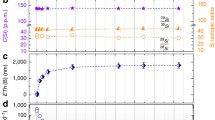Summary
-
1.
“Sodium carbonate paradoxes,” stronger destruction by carbonate solutions or a mixture of carbonate and hydroxide solutions, occur in the treatment of unstable silicate glasses of any composition. The destruction of more stable glasses by solutions containing carbonate ions is less than or equal to that observed in a hydroxide solution.
-
2.
The specific action of a carbonate ion should be attributed mainly to its effect on the solution of silicate groups forming part of the structure of silicate glasses. To a lesser degree, destruction is promoted by the binding of cations present in the glass into difficultly soluble carbonates.
-
3.
The capacity for destroying silicate glasses is also a strong characteristic of orthophosphate ions, which affect the destruction of the silicate groups and bind cations into difficultly soluble compounds. To a certain degree, fluoride and sulfate ions, which affect the same two processes, increase the destruction of glasses by alkali.
Similar content being viewed by others
Literature cited
V. S. Molchanov and O. S. Molchanova, Trans. State Optical Institute 24, 145 (1956).
V. Dimbleby and W. Turner, J. Soc. Glass Techn. 10, 304 (1926).
S. K. Dubrovo and Yu. A. Schmidt, Bull. Acad. Sci. USSR, Div. Chem. Sci. (1955), 403.
V. Dimbleby, C. Muirhead, and W. Turner, J. Soc. Glass Techn. 6, 101 (1922).
M. A. Bezborodov and A. A. Kuz'mina, Coll. “Glass Industry,” 3, 29 (1939).
M. Tarnopol and A. Junge, J. Am. Ceram. Soc. 29, 36 (1946).
A. Mauri, According to the abstract Glasstechn. Ber. 15, 477 (1937).
R. Smith and P. Corbin, J. Am. Ceram. Soc. 32, 195 (1949).
V. E. Tishchenko, J. Appl. Chem. 2, 3 (1929).
I. V. Grebenshchikov and T. A. Favorskaya, Trans. State Optical Institute 7, 72 (1931).
H. Wessel, Silikat techn. 3, 483 (1952).
D. Hubburd and E. Hamilton, J. Res. Nat. Bur. Standards 27, 143 (1941).
V. S. Molchanov and N. E. Prikhid'ko, Bull. Acad. Sci. USSR, Div. Chem. Sci. (1958), 1151.
J. Hensley, J. Am. Ceram. Soc. 34, 188 (1951).
A. Le Chatelier, Silica and Silicates (NKhTI, Leningrad, 1929).
V. S. Molchanov and N. E. Prikhid'ko, Bull. Acad. Sci. USSR, Div. Chem. Sci. (1958), 917.
Author information
Authors and Affiliations
Rights and permissions
About this article
Cite this article
Molchanov, V.S., Prikhid'ko, N.E. Corrosion of silicate glasses by alkaline solutions. Russ Chem Bull 8, 942–947 (1959). https://doi.org/10.1007/BF00916657
Received:
Issue Date:
DOI: https://doi.org/10.1007/BF00916657



